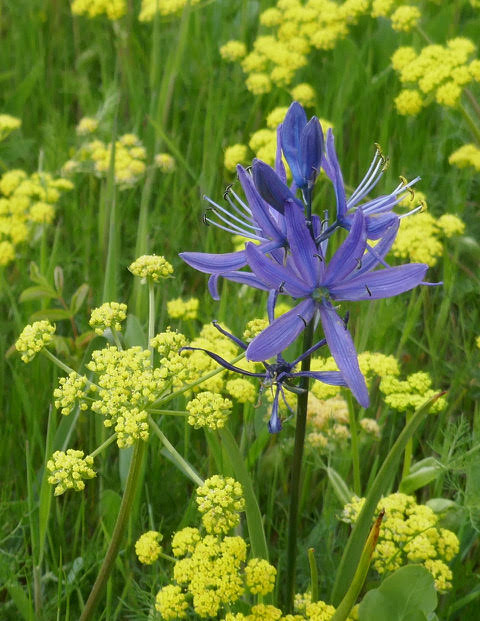by Katherine Darrow • April 2024 marks the 20th year that Washington State has continued a resolution
recognizing the many values and benefits of native plants. What started as a week in 2004, has
expanded to a month since 2021, when our Governor first signed a resolution declaring April as
Native Plant Appreciation Month (NPAM).
This year’s NPAM theme is Prairie Preservation, promoting conservation and education about the remaining fragments of wild prairie. Across North America, prairies are some of the most endangered ecosystems. In Washington, less than 10% of prairie lands that existed prior to European colonization remain.
There are two broad categories of prairie in Washington: the Palouse prairie and Westside
prairies. The Palouse are those found on the east side of the Cascade Mountains in the Columbia
Basin. These prairies have largely been replaced by wheat fields and other commercial crops.
Westside prairies are found south and west of the Cascade Mountains, mostly in South Puget
Sound. All of these areas are classified as “critically imperiled” due to continuing encroachment
of urban and agricultural development. Conserving our prairie lands requires that we limit human
activities within and around them to prevent continued fragmentation and loss of these
environmentally sensitive ecosystems.
In east Jefferson County, we are extremely fortunate to have two remaining prairie
fragments on public lands. One is located at Marrowstone Point in Fort Flagler State Park. This
is a coastal wetland prairie, and is frequently flooded by high tides and winter storms. In early
spring, showy patches of bright pink sea blush are the first to bloom, followed by fritillaries,
purple larkspur, and two kinds of biscuitroot, all in a matrix of grasses and sedges.
The other is our beloved Kah Tai Prairie Preserve, a less than 2-acre patch of upland
prairie located within the Port Townsend Golf Park that is managed jointly by the City Parks &
Recreation Department and Washington Native Plant Society (WNPS). The Preserve features
blue camas, which is closely related to asparagus. The bulbs of camas are highly valued by
indigenous people of the area, who have tended native prairies for thousands of years for this
important food source.
Because of the importance of camas and other native plants growing at Kah Tai Prairie,
this grassland is recognized as an area of cultural significance. An interpretive sign explaining
the cultural history of Kah Tai Prairie, as well as another at the nearby statue of čičməhán
(pronounced cheech-ma-han), aka Chief Chetzemoka, are testimony to the importance of the golf
park landscape, which was part of an extensive camas prairie that stretched across the Quimper
Peninsula prior to the 1850’s.
Today, introduced plant species and development pressures continue to threaten this
ecosystem. Fortunately, new management plans by Friends of the Port Townsend Golf Park aim to restore native plant communities along the course, using sustainable maintenance practices
that reduce the need for water, herbicides, and mowing.
With regard to gardening, the Garden Club of America (GCA) encourages “private and
public landowners to increase the size of existing native habitats and replace lawn areas with
native plant ecosystems.” While it might be difficult for home gardeners to re-create a fully
functioning prairie in their yard, there are many prairie species that could be included in an
ornamental or food garden.
There are dozens of native plant species that grow in our region’s natural prairies. Here
are a few representatives from prairies on the Olympic Peninsula that are commonly available at
regional garden centers. All of these species are easy to grow when planted in sunny places with
dry, gravelly soils similar to native prairies: Roemer’s fescue (Festuca roemeri): Grasses are the foundation of any prairie ecosystem. Fescue is a bunch grass, so won’t make a very good lawn, but works well as an accent in ornamental gardens. Common camas (Camassia quamash) & Great camas (Camassia liechtlinii): Two of Washington’s native camas species are propagated for the horticultural market and can be found as seeds, bulbs, or potted plants at many garden centers. The chestnut-sized bulbs of both can be used as food, but need to be cooked first, similar to potato.
Fritillary (Fritillaria affinis): Because of their dark maroon petals, they are sometimes also called chocolate lily, but don’t taste anything like chocolate! The bulbs of these lilies come apart in small pieces resembling rice, giving them another common name, riceroot. Like camas, they are also edible after cooking. Biscuitroot (Lomatium nudicaule & L. utriculata): There are more than 40 kinds of
biscuitroot native to Washington. On the Quimper Peninsula, these two species are found in our
prairie remnants. They are members of the parsley family and have sweet smelling edible seeds.
Woolly sunflower (Eriophyllum lanatum): Long after blue camas has gone to seed, bright
yellow blossoms of woolly sunflower bloom at Kah Tai Preserve. These are shrubby perennials
that can grow to three feet in diameter, and are easily propagated with cuttings.
Whatever your gardening ambitions, WNPS and GCA discourage collecting from the
wild, where roots and seeds of native plants are necessary to continue their role in a healthy
undeveloped ecosystem. However, if there is permission to salvage native plants due to
impending development, this is ethically congruent with a conservation mission to preserve and
protect the remaining wild places and their flora. Otherwise, it is best to purchase from garden
clubs and nurseries that propagate natives professionally, or trade seeds and cuttings with other
native plant gardeners.
There are numerous books and other resources available on-line and in local bookstores
about how to propagate and grow native plants appropriate for your landscape. Learn more about
gardening with native plants and NPAM events in Washington at https://www.wnps.org
This article first appeared in the Port Townsend Leader April 10, 2024.


